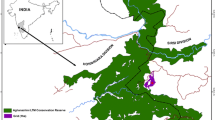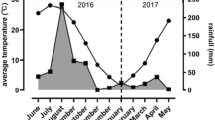Abstract
Feeding sites of Japanese macaques (Macaca fuscata) change according to seasonal fluctuations in food resource distribution. To examine what characteristics of food items affect feeding site selection, I describe herein the seasonal changes in food items, feeding sites, and food resource distributions of this species. Feeding behavior of monkeys and their food resource distributions were investigated on Koshima Islet, southern Japan, for four study periods (i.e., seasons) in 2002. Monkeys showed large variations in their diet between seasons. To weigh the relative influence of the distribution and abundance of food items on feeding site selection in each season, multiple regression analyses were performed by 100 m × 100 m grid. In the analyses, feeding time was a dependent variable and the abundance of staple food items, for which feeding time was over 5% in each season, in each grid square was an independent variable. There was no correlation between the resource distribution of most food items and the distribution of feeding time by monkeys in each season. Monkeys spent more feeding time where multiple staple food items were available. Food items that affected feeding site selection by monkeys had the following three characteristics: (1) clumped distribution, (2) seasonal availability, and (3) fruit. This suggests that monkeys are likely to select feeding sites to consume food items whose availability is limited temporally and spatially, which may enable them to simultaneously use other widely distributed, abundant food items efficiently.




Similar content being viewed by others
References
Agetsuma N, Noma N (1995) Rapid shifting of foraging pattern by Yakushima Macaques (Macaca fuscata yakui) in response to heavy fruiting of Myrica rubra. Int J Primatol 16:247–260
Albernaz ALKM (1997) Home range size and habitat use in the black lion tamarin (Leontopithecus chrysopygus). Int J Primatol 18:877–887
Altmann J (1974) Observation study of behavior: sampling method. Behaviour 49:227–265
Astsalis S (1999) Diet of the brown mouse lemur (Microcebus rufus) in Ranomafana National Park, Madagascar. Int J Primatol 20:193–229
Barton RA, Whiten A, Strum SC, Byrne RW, Simpson AJ (1992) Habitat use and resource availability in baboons. Anim Behav 43:831–844
Braun-Blanquet J (1964) Pflanzensoziologie. 3. Springer, Wien, p 865
Di Fiore A, Rodman PS (2001) Time allocation patterns of lowland woolly monkeys (Lagothrix lagotricha poeppigii) in a neotropical terra firma forest. Int J Primatol 22:449–480
Domingo-Roura X, Yamagiwa J (1999) Monthly and diurnal variations in food choice by Macaca fuscata yakui during the major fruiting season at Yakushima Island, Japan. Primates 40:525–536
Estrada A (1984) Resource use by howler monkeys (Alouatta palliata) in the rain forest of Los Tuxtlas, Veracruz, Mexico. Int J Primatol 5:105–131
Freeland WJ, Janzen DH (1974) Strategies in herbivory by mammals: the role of plant secondary compounds. Am Nat 108:269–288
Gautier-Hion A, Gautier JP, Quris R (1981) Forest structure and fruit availability as complementary factors influencing habitat use by a troop of monkeys (Cercopithecus cephus). Rev Ecol 35:511–536
Hanya G (2004) Diet of a Japanese macaque troop in the coniferous forest of Yakushima. Int J Primatol 25:55–71
Hanya G, Noma N, Agetsuma N (2003) Altitudinal and seasonal variations in the diet of Japanese macaques in Yakushima. Primates 44:51–59
Hill DA (1997) Seasonal variation in the feeding behavior and diet of Japanese macaques (Macaca fuscata yakui) in lowland forest of Yakushima. Am J Primatol 43:305–322
Hill DA, Agetsuma N (1995) Supra-annual variation in the influence of Myrica rubra fruit on the behavior of a troop of Japanese macaques in Yakushima. Am J Primatol 35:241–250
Iason GR, Villalba JJ (2006) Behavioral strategies of mammal herbivores against plant secondary metabolites: the avoidance–tolerance continuum. J Chem Ecol 32:1115–1132
Iwamoto T (1974) A bioeconomic study on a provisioned troop of Japanese monkeys (Macaca fuscata fuscata) at Koshima islet, Miyazaki. Primates 15:241–262
Iwamoto T (1982) Food and nutritional condition of free ranging Japanese monkeys on Koshima Islet Japan during winter. Primates 23:153–170
Iwamoto T (1988) Food and energetics of provisioned wild Japanese macaques (Macaca fuscata). In: Fa JE, Southwick CH (eds) Ecology and behavior of food-enhanced primate groups. Alan R. Liss, New York, pp 79–94
Leca J, Gunst N, Huffman M (2008) Food provisioning and stone handling tradition in Japanese macaques: a comparative study of ten troops. Am J Primatol 70:803–813
Lucas PW, Corlett RT, Kavanagh RP (1991) Relationship between the diet of Macaca fascicularis and forest phenology. Folia Primatol 57:201–215
Maruhashi T (1980) Feeding behavior and diet of the Japanese monkey Macaca fuscata yakui on Yakushima Island Japan. Primates 21:141–160
Mori A (1979) Analysis of population changes by measurement of body weight in the Koshima troop of Japanese monkeys. Primates 20:371–397
Nakagawa N (1989) Feeding strategies of Japanese monkeys against deterioration of habitat quality. Primates 30:1–16
Nakagawa N (1990) Choice of food patches by Japanese monkeys (Macaca fuscata). Am J Primatol 21:17–29
Nakagawa N, Iwamoto T, Yokota N, Soumah AG (1996) Inter-regional and inter-seasonal variations of food quality in Japanese macaques: constraints of digestive volume and feeding time. In: Fa JE, Lindburg DG (eds) Evolution and ecology of macaque societies. Cambridge University Press, Cambridge, pp 207–234
Newton P (1992) Feeding and ranging patterns of forest hanuman langurs (Presbytis entellus). Int J Primatol 13:245–285
Olupot W, Chapman CA, Waser PM, Isabirye-Basuta G (1997) Mangabey (Cercocebus albigena) ranging patterns in relation to fruit availability and the risk of parasite infection in Kibale National Park, Uganda. Am J Primatol 43:65–78
Overdorff DJ (1996) Ecological correlates to social structure in two lemur species in Madagascar. Am J Phys Anthropol 100:487–506
Riañoa D, Meier E, Allgöwer B, Chuvieco E, Ustin SL (2003) Modeling airborne laser scanning data for the spatial generation of critical forest parameters in fire behavior modeling. Remote Sens Environ 86:177–186
Su HH, Lee LL (2001) Food habitats of formosan rock macaques (Macaca cyclopis) in Jentse, northeastern Taiwan, assessed by fecal analysis and behavioral observation. Int J Primatol 22:359–377
Tsuji Y, Takatsuki S (2004) Food habits and home range use of Japanese macaques on an island inhabited by deer. Ecol Res 19:381–388
Tsuji Y, Fujita S, Sugiura H, Saito C, Takatsuki S (2006) Long-term variation in fruiting and the food habits of wild Japanese macaques on Kinkazan Island, northern Japan. Am J Primatol 68:1068–1080
Vedder AL (1984) Movement patterns of a group of free-ranging mountain gorillas (Gorilla gorilla beringei) and their relation to food availability. Am J Primatol 7:73–88
Watanuki Y, Nakayama Y, Azuma S, Ashizawa S (1994) Foraging on buds and bark of mulberry trees by Japanese monkeys and their range utilization. Primates 35:15–24
Watts DP (1998) Long-term habitat use by mountain gorillas (Gorilla gorilla beringei). 2. Reuse of foraging area in relation to resource abundance, quality, and depletion. Int J Primatol 19:681–702
Yamagiwa J, Shimooka Y (2002) Estimation of daily travel distance and home range. Primate Res 18:326–333 (in Japanese)
Zar JH (1998) Biostatistical analysis, 4th edn. Prentice-Hall, New Jersey, p 425
Acknowledgments
This study was partially supported by the Cooperation Research Program of Primate Research Institute, Kyoto University, and a Grant-in-Aid for the Biodiversity Research of the 21st Century COE Program to Kyoto University (A14) from the Ministry of Education, Culture, Sports, Science, and Technology. I thank F. Kanchi and N. Yamaguchi, technicians at the Koshima Field Station, Kyoto University, for their help with data collection. I also thank Y. Muroyama, University of Hyogo, for his helpful comments on an earlier draft of this manuscript. I am grateful to T. Iwamoto and S. Ito, Miyazaki University, A. Mori, H. Sugiura, and the members of the Socio-ecological Seminar of the Primate Research Institute, Kyoto University for their invaluable discussions. All research reported in this study complied with the protocols approved by the Field Research Committee of Kyoto University and applicable national laws.
Author information
Authors and Affiliations
Corresponding author
Appendix
About this article
Cite this article
Go, M. Seasonal changes in food resource distribution and feeding sites selected by Japanese macaques on Koshima Islet, Japan. Primates 51, 149–158 (2010). https://doi.org/10.1007/s10329-009-0179-5
Received:
Accepted:
Published:
Issue Date:
DOI: https://doi.org/10.1007/s10329-009-0179-5




